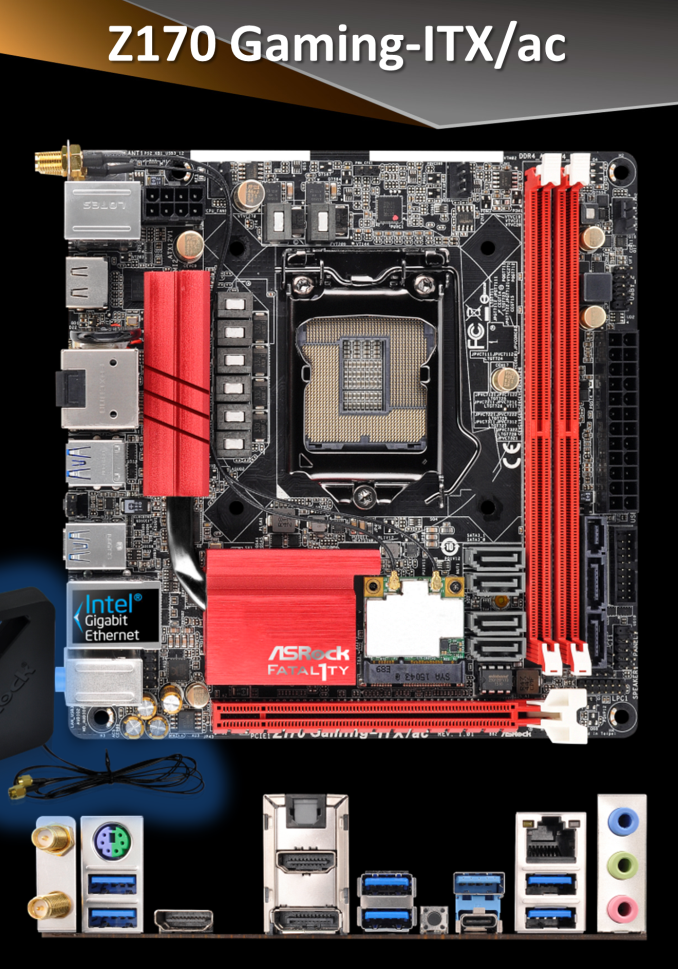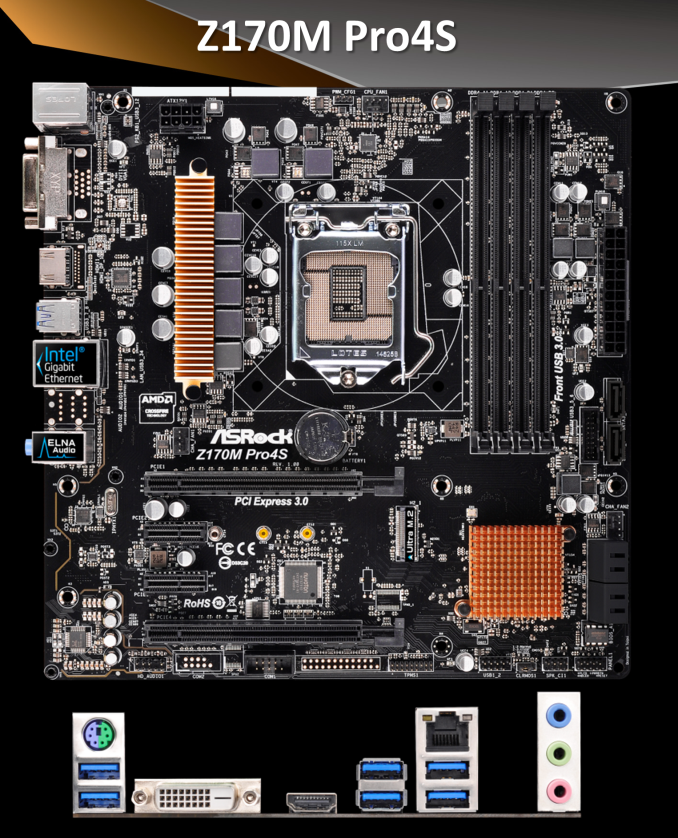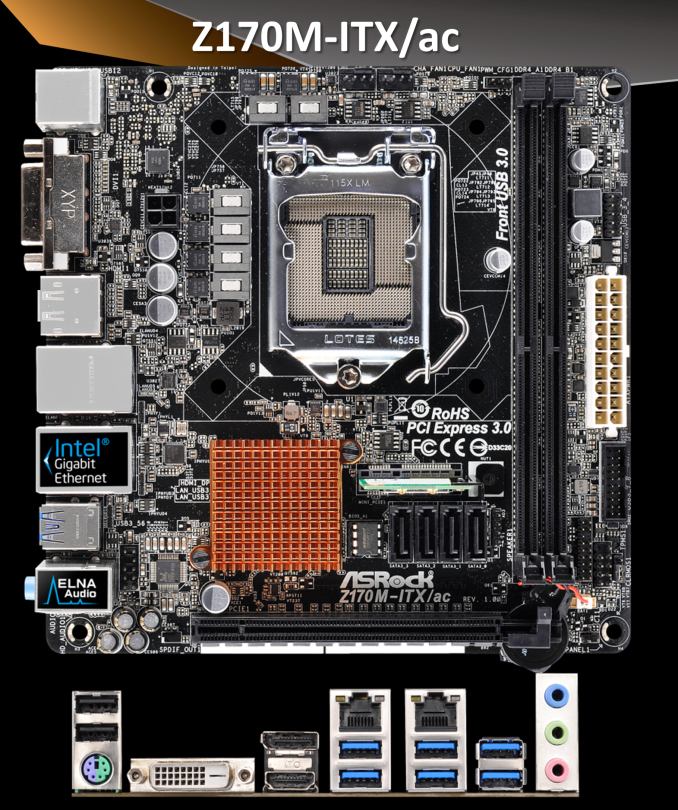Intel Skylake Z170 Motherboards: A Quick Look at 55+ New Products
by Ian Cutress on August 5, 2015 7:59 AM ESTASRock Z170: Mini-ATX and Micro-ITX
ASRock Z170 Gaming-ITX/ac
Everyone loves a mini-ITX gaming motherboard, right? Even if it says Fatal1ty?
Mini-ITX boards are notorious for getting things right, but ASRock has had a go with this one to implement a number of features. Top of the list is probably USB 3.1, where we have both Type-C and Type-A ports on the rear panel. The rear panel also shows an 802.11ac 2T2R dual band WiFi connection, dual HDMI ports and a single DisplayPort. Other networking is from the Intel I219V, while the half-width audio block comes from the higher end ALC1150 codec. My specifications sheet says there is a PCIe 3.0 x4 slot on board, and by the looks of it we would probably find it on the rear as the half-sized mini-PCIe slot is occupied by the WiFi card. There is a total of six SATA 6 Gbps ports on board with a SATA Express as well, and we’re still in the realm of DDR4.
ASRock Z170M Pro4S ($100)
The Pro4S is designed to be the best cost/performance Z170 motherboard on the market, and the successor to the Z97M Anniversary – it does this by shedding a number of features. We are down to six-phase power with half-height heatsinks, a single PCIe 3.0 x16 from the chipset and no USB 3.1. We still get a PCIe 3.0 x4 based M.2 slot due to the number of free lanes from the chipset, but there are no SATA Express here and only six SATA 6 Gbps slots. Networking comes from the Intel I219-V codec while audio is still the ALC892 design. This board still aims for DDR4 it should be noted.
ASRock Z170M-ITX/ac
The solitary mini-ITX board from ASRock being announced publicly is the Z170M-ITX/AC. Not quite sure why they need an M in the name with the ITX being there, but it must be said the board isn’t necessarily built for style:
I’m sure that this board is more aligned with the Pro motherboards than the Extreme motherboards, namely due to the lack of USB 3.1, but it does oddly enough have dual network ports in the form of an Intel I219-V and the Realtek RTL8111E as well as an 802.11ac 2T2R dual band solution included, sitting upright in the mini-PCIe slot. Audio is provided by the ALC892 codec and a total of four SATA 6 Gbps ports are found just past the DDR4 memory slots. These ports are somewhat annoying, meaning that locking cables will easily block out the last cable from being removed without removing all others first. There is an mSATA slot on board as well, and it would seem to be on the rear similar to previous ASRock mini-ITX designs.













85 Comments
View All Comments
utmode - Wednesday, August 5, 2015 - link
Why so many sata express in so many motherboard?Dahak - Wednesday, August 5, 2015 - link
Yeah, I dont get that either, it does not seem like anyone is doing sata express drives, when NVMe is about to come out. Although its only wasting board space as the SateExpress port can double as 2xSATA ports. I was kinda hoping they would have dropped it for this. Maybe on the other chipsets?Kristian Vättö - Wednesday, August 5, 2015 - link
I think the reason lies in the marketing departments wanting to tick a box in the marketing materials. When one manufacturer includes it, everyone follows the suit so their products won't look "inferior" compared to competitors'. It's no secret that SATA Express is practically dead (although I would say it's a miscarriage), but to those with less technical knowledge it may sound cool and better than regular SATA, even though they will end up using SATAe as regular SATA.Ian Cutress - Wednesday, August 5, 2015 - link
ASRock have their USB 3.1 front panel which uses SATA Express, so there's finally some use for it.silenceisgolden - Wednesday, August 5, 2015 - link
It would work better for marketing departments if they market that they "did not bother with the useless standard, SATA Express".DanNeely - Wednesday, August 5, 2015 - link
The design cycle for these boards probably started a good year ago. By the time it became clear that Sata-Express was a dead standard it was too late to make any major design changes for the initial wave of boards.Slash3 - Sunday, August 9, 2015 - link
As someone with 10 SATA devices, I very much appreciate I/O overkill. :)phorgan1 - Monday, December 21, 2015 - link
You can get more sata in less lanes. Once you use up lanes for nvme drives and graphics cards, the smaller groupings won't support more cards or nvme drives (cards need x8 or x16 and nvme drives need x4) the left overs will support usb and sata. Since sata is such lower bandwidth you can still fit a lot of sata in around the fringes, so why not? A sata ssd is still pretty fast.prophet001 - Wednesday, August 5, 2015 - link
Why no slot for M.2 drives?prophet001 - Wednesday, August 5, 2015 - link
Nevermind. Hadn't fully read the article.